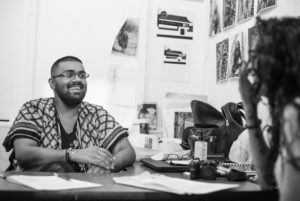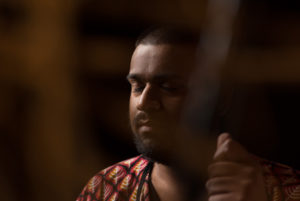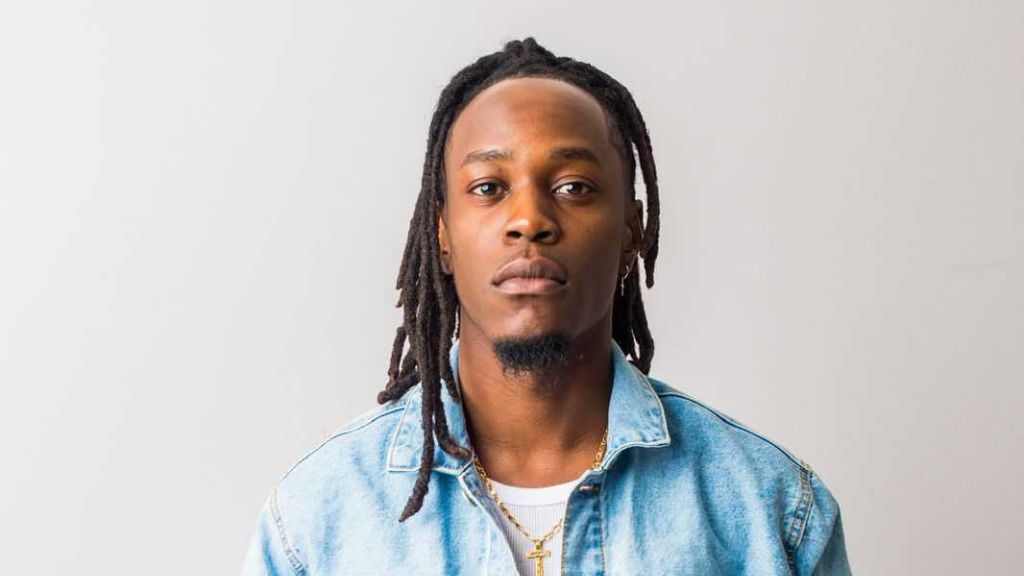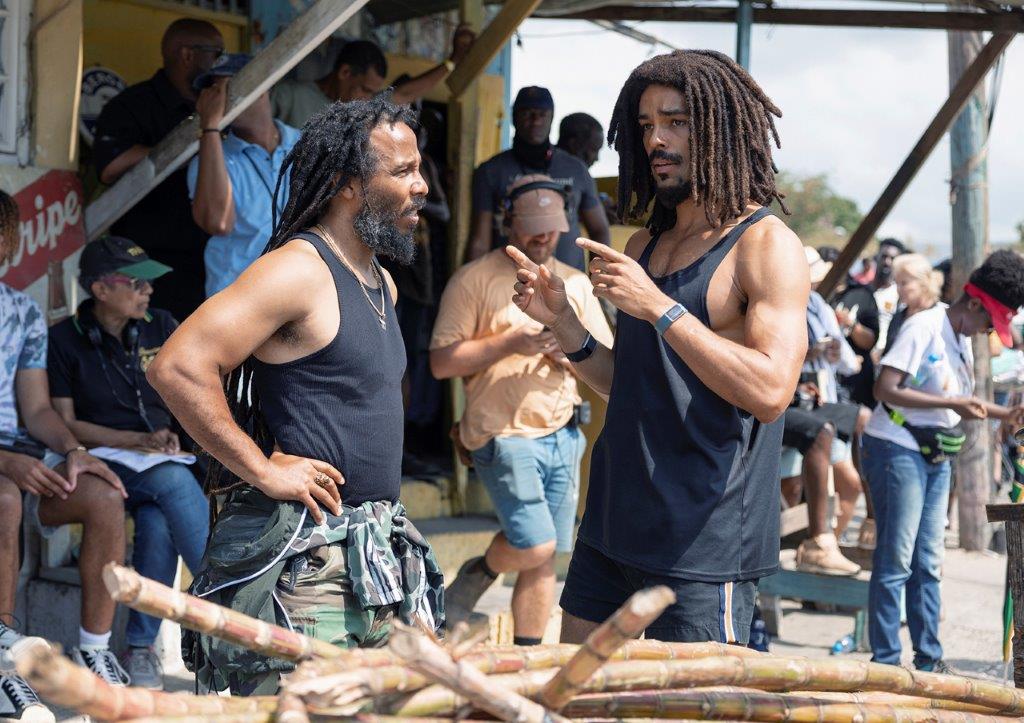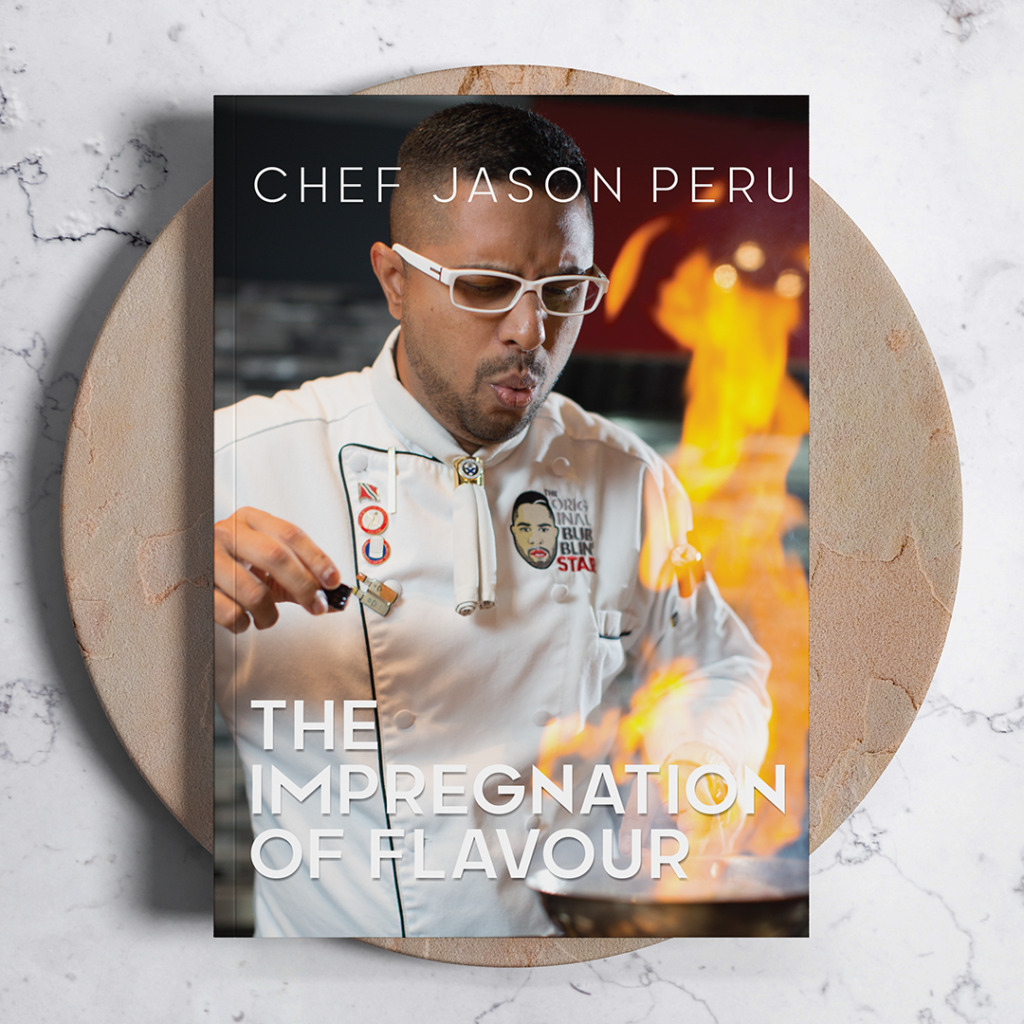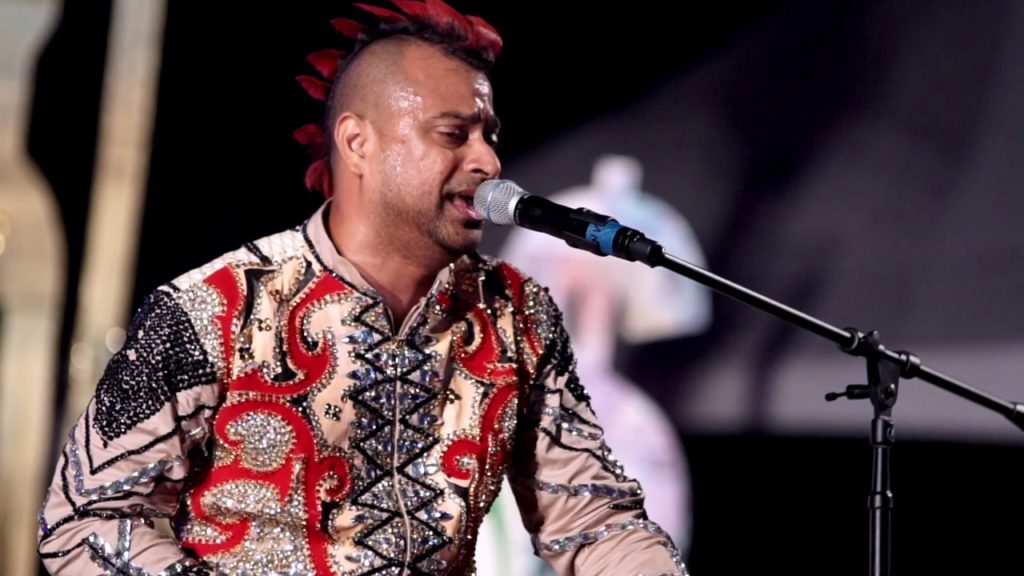THE MAN AND THE VISION BEHIND LOST TRIBE CARNIVAL
Written by WinRadio Admin on April 11, 2017
The Tribe Carnival brand has been a dominant force in all aspects of Trinidad carnival since 2006. In 2015 after identifying a new customer base, the band launched its third concept, ‘The Lost Tribe’. Valmiki Maharaj who designed for both Tribe and Bliss was appointed the role as Creative Director and he brought a new direction and vision to the band.
‘The Lost Tribe’ was a deviation from the costume design style that had brought success to the previous offerings. Not being a big fan of being too uncovered on the road, I wanted to get the story behind the band, get to know the man behind the mas and perhaps get a little inspiration to join the Tribe experience again.
Not your average Mas Man, Val a proud QRC old boy, holds degrees in both Business and in Indian Classical Music. While his office is filled with vision boards and inspirational quotes he finds his true creative voice from the calm that comes from his connection with his music and spirituality.
Sitting in his small office on Alberto Street in Woodbrook, with a half empty bag of red wine removed from its box packaging between us to share, Val’s humour and openness set the mood immediately. His personality is as witty, bright and colourful as his designs and from that moment, there was no doubt in my mind why everybody loves Val.
Di: How did all of this start for you?
Val: I started working with Diane Hunt and Peter Elias on fashion shows and Fashion week. Since my school days I knew that I was the kind of person that had to learn from experience so I decided to just do trial by fire. Then my last year in university I started in carnival.
At the end of 6th form I picked up my portfolio and I went walking around to all the mas camps. I remember Gerald Hart being so nice to me. He was very encouraging and told me that if I wanted to come and work in the mas camp I could but I did not end up going to work at Harts. I was instead given an opportunity to design at another well-known band but it was not a pleasant experience, not because of the band itself because they were great to me and I learned a lot from it but they put me to work with someone who took advantage of my creativity. I was so depressed about it and found carnival to be this nasty industry! I decided I was going back to Canada and not staying here.
Di: What made you stay?
Val: I met Wayne Sankar who used to work with Meiling and he told me to join him working production at another band.
There I helped him do things like put fibre glass rods in the bussle skirts and stich and sew. It was such a fun time. We would work and then go to Frankie’s for a drink, then storm a few fetes, then go back to the camp take a sleep and then go back to work. I did not play mas in costume with the band but as a part of the team that year I decided to just jump with them but for the entire day the big bad Tribe was blocking us.
Everyone was upset about it so I decided to see what the Tribe band was about and stormed the band for the entire of Tuesday!
I drank and ate and had a great time especially since I knew a lot of people playing in the band. That experience turned me toward Tribe as a masquerader because of the level of service. I had always kept in contact with the managers of Tribe, Dean and Monique, sending them emails. It was just simple communication. Then one day Dean called asking me to go to the mas camp because they needed some costumes done. I went and I designed two costumes for them and the rest is history.
Di: You went to Queen’s Royal College. A lot of creative men in different areas came from your generation at the school. How was your experience at the school?
Val: Two things stand out from QRC, creativity and sport. I think QRC is a place that encourages a certain level of confidence. I have always said it was an alpha male school. When you walk in there if you are somewhat weak you will not have a good experience. I have friends that have had extremely opposite experiences of QRC. Some loved it like me and some say they absolutely hated it.
Di: QRC is fairly well known, as an alpha male school isn’t it? How was that experience?
Val: I was raised in an environment that encouraged confidence and creativity and I never heard my mother or anyone ever tell me I was being too girly or too this or too that. I’m not sure if it was because she knew what she was doing or if it was because she was loving.
QRC was an environment where you either sink or swim and they respect people who respect themselves. I saw situations where there were young gay boys around me that did not get the same respect I did. I am not saying that I did not go through some of the same discrimination but for some reason for me it was like water off a dasheen leaf and it rolled off. There were moments when it was hard. I have stood at the back of buildings and cried because you feel affected by it but that was a very, very short stage.
After QRC and university there was my entrance into carnival and it was ironically very difficult.
At that time it was a setta red girls designing costumes and all of a sudden this overweight Indian boy with long hair who likes to wear every colour on the planet, jump up and jumped in the mix.
One of my nicknames of sorts is Valerie and someone posted something on social media and called me Valerie and a friend called me and said that I should not be allowing people to demean me like that and I told him it only demeans me if I allow it to.
At times I have to remind myself that as a young Indian gay man in society I have to work ten times harder than anybody else. I always tell gay young men that we need to work ten times harder than any straight person and any girl for anything that we need to get however, the world cannot deny beauty or success so kill them with success.
“The world cannot deny beauty or success so kill them with success.”
Di: What does it mean to be the Creative Director of The Lost Tribe?
Val: Head cook and bottle washer. That is basically what it means. I don’t know, I’m not a titling type of person or at least I try not to be so it doesn’t really have any kind of connotation to me really. At the same time living in a world where it does have connotations allows me to create and do shit. The Lost Tribe’s aesthetic is very me. I come up with concept and creative for the band.
Di: What is that creative and business life like?
Val: It is very difficult. Every day I wish that all I had to do is create. I do not like punching numbers. I do not like budgets or invoices it is killing my every hair of creativity. Right now I am working on 2018 and I feel like 2018 will be further if I wasn’t marketing this band right now and if I was not working on events and if I was not finding ways to make the band more relevant and current because yes, we are in to creativity but I am not painting things and putting them in a gallery. My business is entertainment. In entertainment you have all of a 5 second window of opportunity where you are cool and then you just aren’t cool anymore. So I need to keep doing things to keep the band top of mind and keep it active. That is why I am happy that I am where I am in the organization because I have control over the branding, the image and all of that for The Lost Tribe. Now Tribe is more conscious of its brand and image, it is not ‘We are Tribe. We are carnival. Hear us roar!’ it is, ‘We need to show our soul’.
People feel they can just open a business just so and a carnival band is a business. You need to have a market you need to have a voice. You need to design for a person. You can’t just open because there are people to play mas. You have to fulfill some need.
Di: What is your creative process?
Val: There is no process. When things come and make sense to me I write it down. The story of The Lost Tribe was written on a plane. I have not been very successful but, I try to involve myself in a lot of spiritual activity. I try to think beyond the boundaries of commerce, which is my challenge right now.
Di: You are Hindu and a ‘Mas Man’. How does that work and how does it affect your creativity?
Val: I believe that this creativity is not mine. I grew up in the Hinduist home of all the Hindu homes that were ever Hindued. My mom made sure that we were on that temple run and I always believed as I was taught that, this creativity is not ours it comes from somewhere else. There is a creative being, a creative universe and creative consciousness. We believe in Saraswati Mata, the goddess of creativity, music and art and I have conversations with her, that’s how I pray. I say I know that I have to use my voice and the day that I stop using it for good things it will stop. I have seen it happen with people and they don’t understand why. I would like to have my creative consciousness as clear as possible so there are things that I don’t do. My parents got me involved with Indian Classical Music from a young age at the Ashram at our temple. I have a BA in Indian Classical Music as well but I do not associate my vices with my music at all. I do not drink and do music. I don’t do my music in any secular environment. I get up in the mornings I play my harmonium and I sing for myself. It is my meditation. It makes me feel and think clearer. I used to also go and meditate for hours and people will notice the difference. I create whether it is in colour or notes. I see myself as some sort of channel that creativity will pass through and I would like to not lose that and there are times where I don’t feel like I am 100% there. I need to be 100% there but it is difficult with the business aspect infringing. It is not an easy process but it is a process that seems to work.
Di: How do things work? What is the design process of creating and making Lost Tribe?
Val: Woo! That is a big question there. The design and creation process happens at least a year and a half in advance. I however, have themes for the band for 5 years in my mind. I am very visual person so I see the photoshoot and create a story and I see parts and parts of it coming together before I start to see the details. I develop boards to present to the designers, so they know what the shapes and methods are, which is something I think we are missing in carnival. There are so many different designers that is necessary as a marketing strategy but I need to hold my designers together. I know they all want to bring their individual style but when they come together they must all look like sisters. I sketch and design a band before I go to the designers to present the band. The designers come back with concepts and we approve and select the design team and sign contracts with them and tell them to leave their egos at the door. Last year we did 100% local production but this year we are doing ‘Made in Trinidad’ because we are assembling in Trinidad but I have to do parts away because our industry is not ready yet. I tried but we need development of skillset, we don’t have enough producers and we don’t have enough trustworthy people. I want to get to the point where we can tag the costumes Made in Trinidad or Final Stitch in Trinidad. We are also experimenting with our production methods as well like last year we used a water jet cutter instead of scissors. That allows for more work for the producers and more interesting things for them to do as well instead of just placing feathers.
Di: What is it like from Monday and Tuesday?
Val: On Monday I don’t have to go to see the band move off. The system is as such that with or without me the band will move but that is my child I want to see it on the road. On Tuesday however I do all the administration things like give the print out of the description of the band to the judges and the registration card and so on and I think it is important for the masqueraders to see me. I literally walk around the band asking people, whether they know me or not, if they are ok and if they need anything. On Ash Wednesday I eat a Patraj roti, a diet coke and cheese puff… every year. I just wake up put on a shades and a slippers no bra and go out the road to Patraj in El Socorro, not the one in town. Then I sleep and try to go to a movie that evening so that I can eat everything they have to offer. That type of behavior continues most likely for the rest of the week and I also feel the need to party. Then I deal with after carnival issues. Touching base with people and paying invoices and those sorts of things and then head straight in to the band for the next year.
Di: What was the purpose of Tribe creating The Lost Tribe?
Val: When I got in to carnival there was a lot of bikini and bead mas. Of course Tribe at the time was the biggest carnival and biggest carnival conglomerate in the industry so I was very honoured to be a part of it. I mean don’t get me wrong, I love bikini and bead mas however when I started designing, I did not start by designing that. I started by designing more theatre-esque costumes that did not fit the bill at all so I had to adjust it for bikini and beads mas and years went by and we continued designing. I was blessed because it continued to work for me but in my mind I think even beyond that there was always a need for a little bit more. I’m not saying that with any shade to bikini and bead mas whatsoever but, if The Lost Tribe did not come about or the possibility of it at least I probably could have counted my days in carnival. Not with any intention as to what else I could have been doing but I felt like I had done it and my creative soul needed some upliftment. I needed something else to happen and I believe in time and place and opportunity. I had a car accident and it subliminally led to the way that I approached my thought process. The Lost Tribe’s approach has never been design in carnival alone but rather it should be a cultural hub so we do the Front Yard Films, people are looking for those indi-contemporary type of things to do. How much drink yuh go drink? How much fete yuh go fete? I mean I like to party more than anybody else but people want something else. So we are creating a different movement in entertainment and a different movement in carnival that I call the hybrid carnival. That is where I see our contribution right now. I can’t say what exactly the contribution is but I feel like in three years I can look back and tell you what happened there.
Di: How did Front Yard Films happen?
Val: I needed to start having brand building events that were not fetes because The Lost Tribe is not a fete company. As a new company that was and is still trying to validate its name as a cultural entity there are things I needed to do. We also had no money so it had to be something that was free full stop. We found a way to use Seigert Square through the city who has been very kind to us and they were happy were doing community building activities as well and we decided to have a movie night. We showed the Peter Minshall film for the first one and we invited him and he came. It was great and it was nerve wracking but about one hundred people came despite the rain and now it has grown to about three hundred and something persons. We need to find a way to make it sustainable though, whether from donations or from sponsors.
Di: What are your goals with Tribe and in general?
Val: I started telling myself that I wanted to make some kind of contribution to society to the culture not that I wanted to be the next Minshall or the next Minister of Culture but I want that when I have gone that there will be something else. People don’t remember a lot of bands from the past and by that I mean the people involved with them, not that I want people to just remember my name, since The Lost Tribe has started I have seen the change in the way people are approaching things in general. Myself and some other people are working on a project that will be happening at the beginning of carnival. One person involved usually would not be associated with this kind of event. Even the Tribe designers, the way they approach their designs. I have seen other companies adding cloth. I have seen Barbados Carnival coming to me saying they want The Lost Tribe to come in to their carnival whereas Barbados has been skimpier than Trinidad carnival. When you look at the things people reach out to because already I can see the influence we are having in the current ranks. I saw a band last year that put in their presentation a rhythm section and I was like WTF because it had no place there in that presentation but at the same time, I was happy because men were getting to eat a food and the culture is being spread. Even some of the 50th anniversary celebrations on the Avenue people were more receptive to the culture. I am not saying that all of that is on my shoulders but
‘if you build it they will come’.
